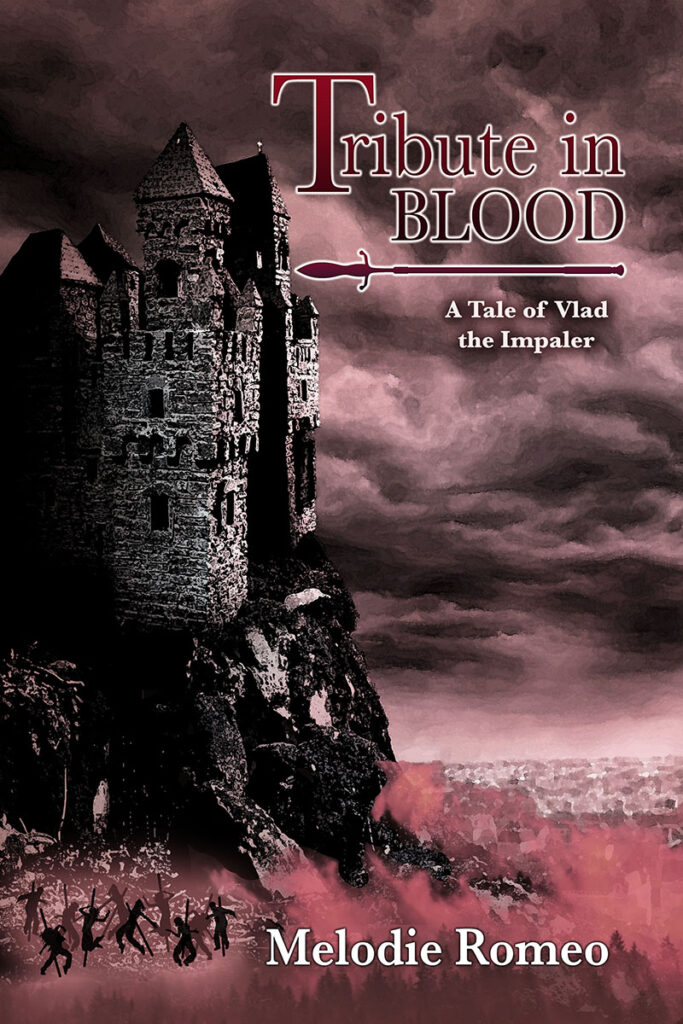Welcome to my stop for the blog tour organized by Tomorrow Comes Media for Tribute in Blood by Melodie Romeo! Today is day 1 of thrills and romance immersed in a historical setting as you explore Tribute in Blood, by Melodie Romeo, in a new blog tour taking place November 25 to December 2! Melodie’s pen name is Edale Lane and I hosted her previously when she shared about her education in History and how that has influenced (or the other way around) her Historical fiction writing. Today, she has compiled a list of 10 little known historical villains who can offer perfect inspiration for Historical fiction writers as well as readers who love diving into history.
Let’s learn a little more about Melodie before we dive into her guest post, and then after, I’ll share the book cover and synopsis with you.

About the author
Melodie Romeo, who also writes under the pen name Edale Lane, is the author of the award winning 2019 novel, Heart of Sherwood, and the Night Flyer Trilogy. As Melodie Romeo, she has written Vlad a Novel (soon to be re-released as Tribute in Blood), Terror in Time, and others. She founded Past and Prologue Press in 2019. Both identities are qualified to write historical fiction by virtue of an MA in History and 24 years spent as a teacher, along with skill and dedication in regard to research. She is a successful author who also currently drives a tractor-trailer across the United States. A native of Vicksburg, MS, Melodie is also a musician who loves animals, gardening, and nature.
10 little known Historical Villains
When I set out to write a historical thriller-romance in 2000, I began by asking myself the question, “Who is one of history’s most evil villains?” Research led me to Vlad Tepes, Prince Dracula, because there was enough written about him for a good foundation and enough unknown to allow leeway to craft a plot. But who else could I have chosen? Everyone knows about Nero and Hitler, Stalin and Rasputin—notorious historical figures about whom many books have been written. Pol Pot and Idi Amin of the 20th century were not anomalies; ruthless tyrants have reigned death on humanity since the dawn of civilization. But what about equally horrific obscure men and women that historical fiction or alt-history authors may wish to explore? Here are ten listed chronologically; I’ll leave it to you to decide who was the worst.
10. Phalaris (570 BC-554 BC), tyrant of Agrigento (Sicily), is remembered for his great cruelty. He enjoyed roasting his enemies inside a bronze bull full of fire, the poor victims cooked alive while their screams represented the roar of the bull named for him—the Bull of Phalaris. Among his alleged atrocities is cannibalism: he was said to have eaten suckling babies. In an ironic twist of fate, Phalaris was burned alive in his own instrument of tortuous death.
9. The Thirty Tyrants: Athens (404-403 BC) After Athens lost to Sparta in the Peloponnesian War, a new governmental oligarchy was formed of thirty men led by Critias, Theramenes, and Charicles. While their rule only lasted thirteen months, they managed to murder five percent of Athens’ population, including each other. The Thirty killed thousands of citizens in a brief space of time, including approximately 1,500 of the city’s chief democrats. They executed wealthy Athenians and shared their money amongst the Thirty’s supporters. The tyrants even created a group of three hundred whip bearers and charged them with frightening the city’s residents. After capturing the towns of Eleusis and Salamis, The Thirty executed the male inhabitants of both towns. Sparta ultimately intervened to help re-establish Athens’ famed democracy.
8. Emperor Qin Shi Huang of China (259 BC-210 BC) was the founder of the Qin dynasty and the first emperor of a unified China; he also attempted to destroy all learning and education. The same man who initiated construction of the Great Wall and had his own mausoleum created with an army of 6,000 terra-cotta warriors and horses, burned books, destroyed libraries, and buried several hundred scholars alive. An account tells that in 211 BC a large meteor fell into the Yellow River with words inscribed on it that read, “The First Emperor will die and his land will be divided.” When Qin Shi Huang found out, he sent an imperial secretary to investigate. No one confessed to having written on the stone, so all the people living nearby were put to death and the meteorite destroyed. After three assassination attempts, the emperor died of an illness… or was it perhaps poison?
7. Liu Ziye, (449-466) Emperor Qianfei of China’s Liu Song Dynasty, was an immoral ruler in a line of depraved despots. He started out by killing off various family members, including his brother and several uncles. Copying his father’s incestuous leanings, he took several aunts and cousins as concubines and ordered all of the princesses to come to his palace for sex. When one aunt refused, he executed her three sons. His homicidal tendencies were not limited to family members, as he took revenge on members of the court who he dreamed had spoken negatively about him, then followed that with a ghost killing ceremony because a murdered handmaiden revisited him in another dream. Eventually, one of his uncles had enough and assassinated him.
6. Wu Zetian (624-705) was the only woman to rule China independently… and she was a sadistic murderess. While being recognized as a capable ruler who appointed adept officials, she also executed all of her rivals, including the former Empress Wang, members of her own family, even her newborn daughter! She frequently ordered executions and suicides while driving the lucky ones into exile and made use of secret police to terrorize the masses. Throughout her reign she preserved power by strangling, poisoning, mutilating, and burning or boiling her subjects alive.
5. Tamerlane or Timur (1336-1405), who claimed to be a descendent of Genghis Khan, was a Turco-Mongol conqueror considered one of history’s greatest military leaders and strategists. His empire included Transoxiana, parts of Turkestan, Afghanistan, Persia, Syria, Qurdistan, Baghdad, Georgia, Asia Minor, southern Russia and parts of India. To create this empire, he destroyed entire cities, killing tens of thousands of civilians in addition to soldiers. Tales say that in Baghdad he beheaded 90,000 people and built towers out of their rotting skulls. Tamerlane was adept at the most brutal methods of torture and did not hesitate to skin people alive for not accepting Islam.
4. Ferdinand I of Naples (1423-1494) had an ignoble start in life as the illegitimate son of Alfonso V of Aragon, but that did not stop him from racking up bodies once he became king. Historians consider him brave and politically astute, but a ruthless ruler who plotted against his enemies—which happened to include Pope Alexander VI. After capturing opponents, Ferdinand would promise them amnesty then murder them instead, mummifying their bodies and putting them on display in a museum dressed in their own clothes. If he suspected anyone was conspiring against him, he would treat them to a tour of the museum which had a quelling effect his guests.
3. Countess Elizabeth Báthory (1560-1614) of Hungary holds the record as the most prolific murderess in history. Though no one knows for sure how many young women she killed, they cited the number 650 at her trial. Stories of Báthory’s sadistic serial slayings were verified by the testimony of over 300 witnesses and survivors and supported by physical evidence of horribly mutilated dead, dying, and imprisoned girls found at the time of her arrest. The tale she bathed in the blood of virgins to maintain her youth persists to this day.
2. Murad IV (1612-1640) was a Sultan of the Ottoman Empire who began his reign at the tender age of eleven, but that did nothing to dissuade his cruelty. Among other atrocities, he killed his siblings, banned smoking and coffee (making their use punishable by death), and hanged or impaled anyone who defied him—and that was only the beginning. He had advisors strangled to death in his presence, executed scores of high-ranking military officials, and he had the head of the Islamic Supreme court assassinated. Reportedly, he would sit by the water near his Seraglio Palace and shoot arrows at any passerby or boatman who rowed too close to his imperial compound, seemingly for sport.
1. Ranavalona I (1778-1861) was called Ranavalona the Cruel or the Mad Queen of Madagascar. Adopted by the royal family, she married the king’s oldest son who died a painful death from either syphilis or her having dosed him with poison, leaving her as ruler of the island nation. Her first act was to kill off the remaining royal family members. Ranavalona was so ruthless that she cut the country’s population in half. Rather than demand taxes, she forced brutal labor on her citizens, literally working them to death. An estimated 10,000 subjects died constructing a road that she demanded be built before her eyes. She also persecuted Christians with both torture and execution. Several thousand Christians were killed during her reign, and most foreign missionaries fled the country.These are but a small sampling of crazed, bloodthirsty authoritarians scattered throughout time. Comparing them to despots of the 20th and 21st century, I am reminded of a lesson history has taught me: the more things change, the more they stay the same.

The most terrifying horrors are revealed in the pages of history.
After killing over 100,000 people during his first reign as Prince of Walachia, Vlad has returned, ready to inflict tortuous death on anyone he chooses. Only Nicolae and Maria, drawn together through mutual tragedies both inflicted by the ruthless Prince Dracula, dare try to stop him. Can Nicolae fulfill his plan of justice and revenge while winning the heart of the lovely Maria, or will he become the Impaler’s next victim?
With heart-stopping danger at every turn, detailed historical accuracy combined with fictional characters, and a myriad of surprises, Tribute in Blood is sure to keep you on the edge of your seat. Order this historical thriller-romance today!
Want to read Tribute in Blood? Find it on Amazon (Print, Kindle).
Thanks for stopping by today! Be sure to visit other stops on the tour! The Tribute in Blood Blog Tour features reviews, interviews, guest posts, top ten lists, and more!
Check out where they were on Tomorrow Comes Media.

Cover image: Writing desk Photo by Clark Young on Unsplash

Be First to Comment